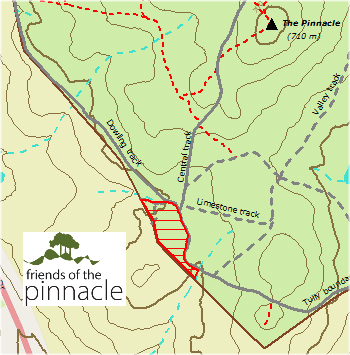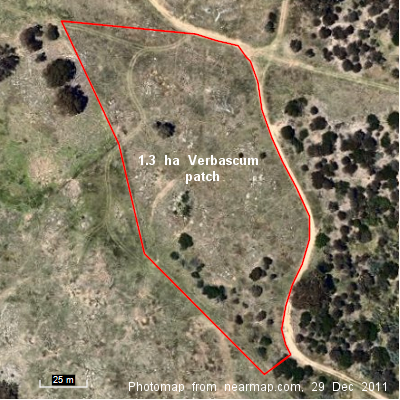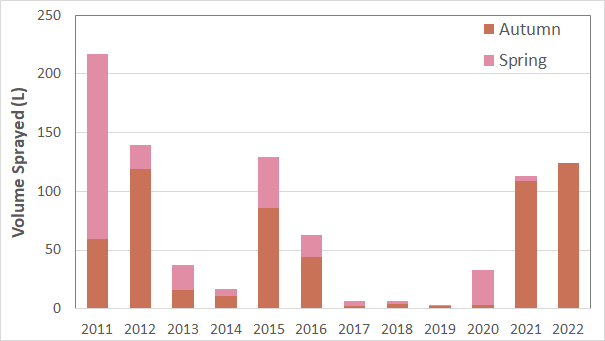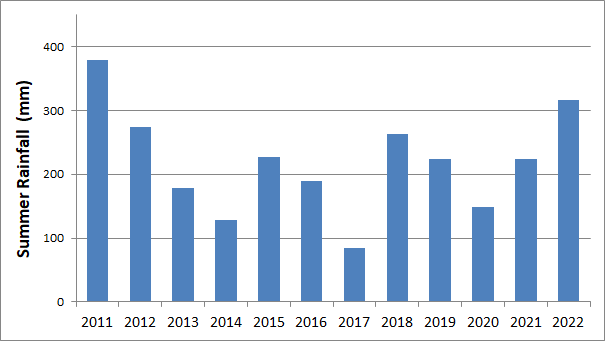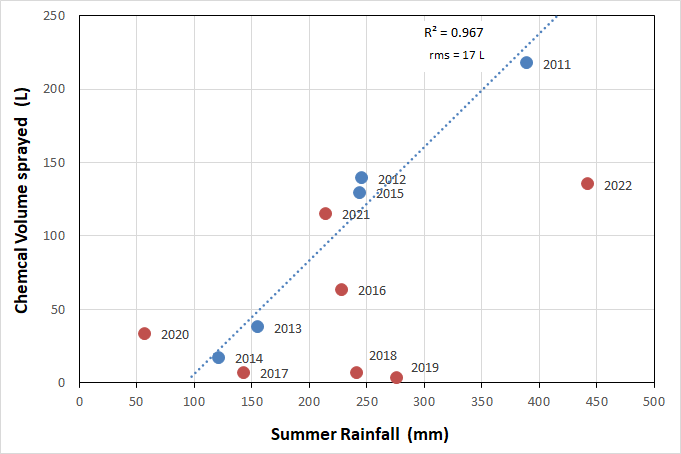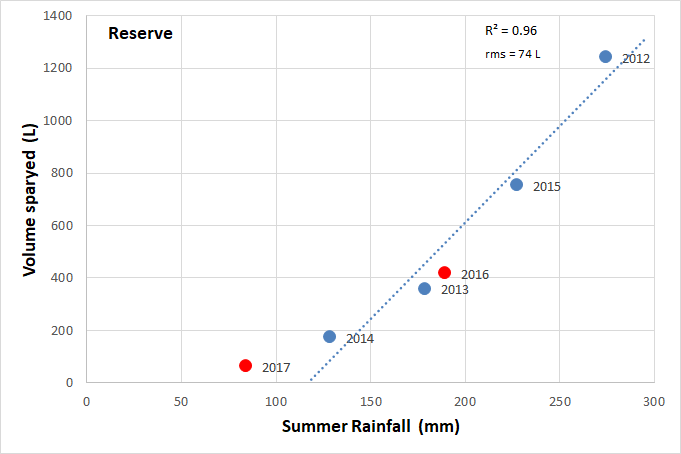 
|
measuring the effectiveness of Verbascum control |
|
Determining what controls Verbascum prevalence Measurements and analysis by Warren Bond Summary and Conclusions Based on 13 years of observations, there is strong evidence that the sum of rainfall in the months of November, December and January is a strong determinant of the prevalence of Verbascum in the subsequent 12 months. Negative deviations from this observed relationship in recent years may indicate success in controlling Verbascum or that further factors are affecting its germination and growth. One of fotpin's target weeds for many years has been Verbascum, both Verbascum thapsus (great mullein) and Verbascum virgatum (twiggy mullein). Both are captured in this pop-up photograph taken by Rosemary Blemings in 2007. Verbascum thapsus are the paler plants with thicker flower stalks, while Verbascum virgatum are the darker, thinner plants. Both have the ability to invade an area and proliferate, dominating the vegetation, as the photograph shows. After several years of grubbing, lopping and bagging of seed heads, comprehensive and systematic spraying of rosettes across the Reserve with Brushoff (active ingredient metsulfuron-methyl) was commenced in 2011. After the first two years there was a noticeable decline in Verbascum present, time taken and amount of chemical used. In order to better quantify this decline, compilation of effort (hours spent spraying) and volume of chemical sprayed was begun for a 1.3 ha heavily infested trial patch that included the area where the photo above was taken. The exact area of the trial patch is shown in the maps below.
Record of effort and chemical usage for the example Verbascum patch It can be seen that after intensive treatment in 2011 the amount of chemical required to control Verbascum in this trial patch had decreased considerably (> 90%) by 2014. In 2015, however, there was a seven-fold increase in the amount of chemical required, bringing it back to 60% of the value in 2011. This was followed by a decline over the next three years, to an average of just 5 L, a mere 2.5 % of what was used in 2011. The amount used rose steadily again from 2020 to 2022.
Volume of chemical required to be sprayed to control Verbascum in the trial patch, separated into spraying in autumn and spring. In 2015 it was was concluded that the large increase in volume used was the result of a large amount of germination of Verbascum (and many other weeds) in response to the above average rainfall in November and December 2014. Closer examination of rainfall records and comparing them with the amount of chemical required each year suggested that rainfall in the three months November to January (hereafter called summer rainfall) may be the controlling factor in Verbascum germination and prevalence in the subsequent 12 months. This can be seen by comparing the chart below of summer rainfall with that above for volume sprayed over the first five years of records.
Summer rainfall is defined as the sum of rainfall in November, December and January. For 2011, it is the sum of rainfall in November and December of 2010 and January of 2011. The relationship between the chemical volume required to control Verbascum in the trial patch and summer rainfall is more clearly displayed in the chart below. For the first five years, the correlation between the two produces a regression coefficient of 0.967 and a residual mean square (rms) of the deviation from the regression line of the measured chemical volume for each point of just 17 L (16% of the average annual volume sprayed).
Regression of annual chemical volume required against summer rainfall for the trial patch. The regression line was fitted for the first five years only (blue dots). To date all but one point for subsequent years (red dots) fall close to or below that regression line. This good regression for the first five years of data suggests two things. Firstly that there is a strong relationship between summer rainfall and chemical volume required for the trial patch during this five year period. Secondly, if this relationship is causal, the chemical volume required in the first five years was determined purely by rainfall; the effect of spraying on Verbascum prevalence was minimal at best. It can be seen that the chemical volumes required were negligible in 2017, 2018 and 2019. In 2017 the volume is consistent with the prediction of the regression line that there should be no spray required (ie. no Verbascum growth) for summer rainfall less than about 100 mm. The 2018 and 2019 observations also suggest virtually no Verbascum growth despite summer rainfall amounts suggesting at least 100 L of spray should be required. This may be an indication of temporary success in controlling Verbascum following a very dry year. Alternatively it suggests that some other factor, as yet undetermined, was affecting Verbascum germination and growth in these seasons. The exception to the analysis above was 2020 when the regression line predicted no growth (ie. no chemical required) but 33 L was sprayed. Several factors may have influenced this. 2019 was the second driest year of the last 50 years and this trend continued into January with the result that the summer rainfall (defined here as November to January) was the lowest by far in our 13 year history. Above average rainfall was experienced in the first half of February 2020 and if that was included summer rainfall for 2020 would have been 163 mm and the volume for 2020 would have been below the 55 L predicted by the regression. The definition of the period for measuring "summer rain" is unlikely to be precise to less than 2 weeks. Other factors affecting germination and growth of Verbascum and competing plant species may also have had an influence following a drought year and very high summer temperatures. Application the the whole of the Reserve Between 2012 and 2017, inclusive, Verbascum was systematically and thoroughly sprayed across the whole of the Reserve. After 2017 the amount of Verbascum was quite small and spraying was restricted to the worst areas because of time constraints; other control measures were used for the rest of the Reserve, including dabbing and pulling. Data similar to that for the trial patch above is therefore available only for 2012 to 2017, and is shown below.
Regression of annual chemical volume required against summer rainfall for the whole Reserve. The regression line is fitted for 2012 to 2015 only. In this case, the regression was fitted to the four years of observations from 2012 to 2015, resulting in a regression coefficient of 0.96 and an rms of 74 L (12% of the average annual volume sprayed). The 2016 and 2017 points follow a similar pattern to those for the trial patch alone. Comparing the regression lines for the trial patch and the whole Reserve The slopes of the regression lines shown in the charts above for the trial patch and the Reserve are very different. This is partly because the volumes sprayed are for very different areas, 1.3 ha for the trial patch and 133 ha for the whole Reserve. Even when expressed on a per hectare basis there is still a ten-fold difference between them: 0.64 L/ha/mm* for the trial patch and 0.055 L/ha/mm* for the whole Reserve [* L/ha/mm is Litres of spray per hectare per mm of summer rainfall]. While the regression slopes are very different for the two areas, the intercept on the horizontal axis is almost identical: 107 mm for the trial patch and 117 mm for the whole Reserve. These values represent the amount of summer rainfall below which no spraying is required, i.e. Verbascum does not germinate and survive. The fact that these two values, obtained from very different areas, are not significantly different provides support to the robustness of the hypothesis that there is a causal relationship between summer rainfall and Verbascum growth.
|
© Friends of The Pinnacle
